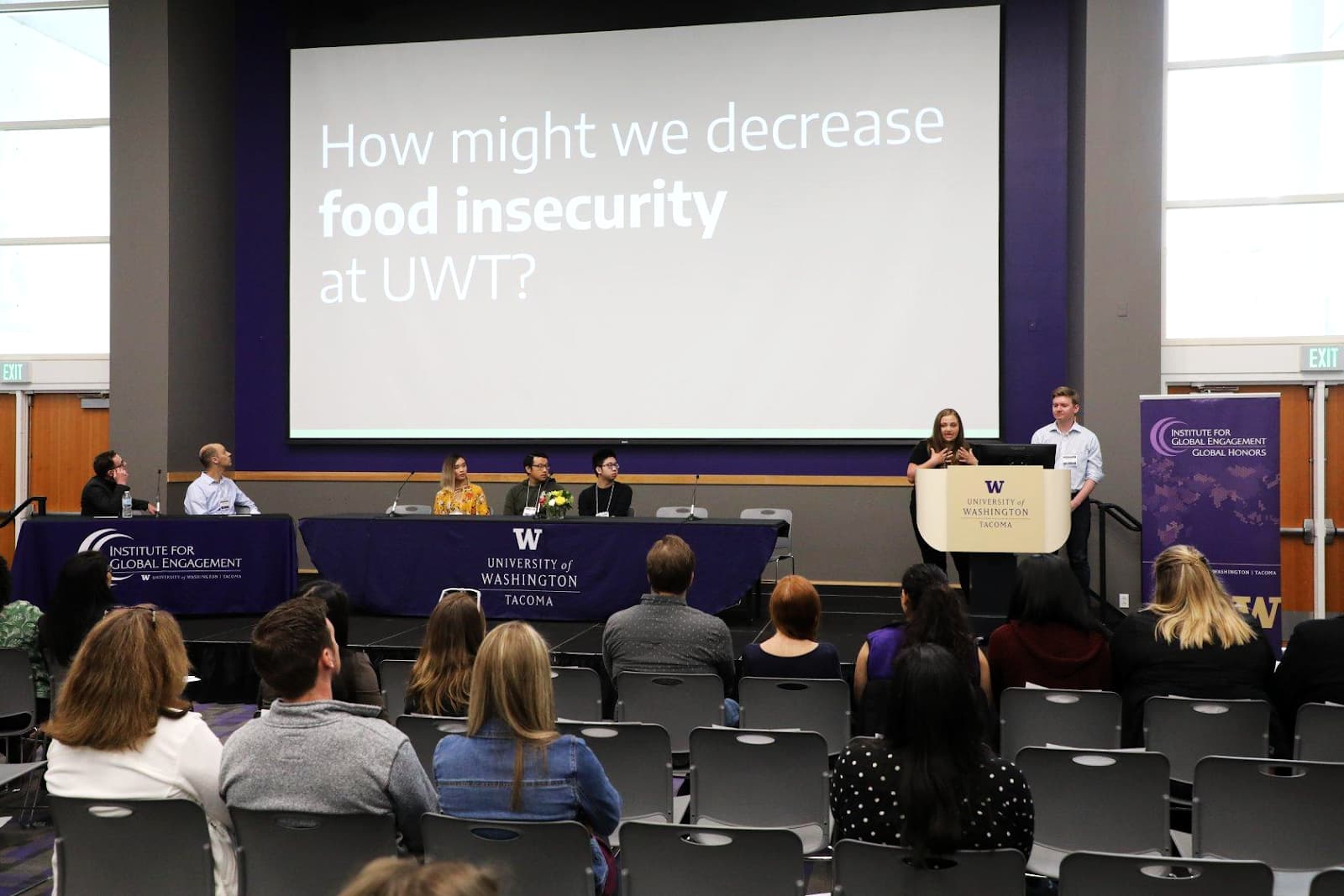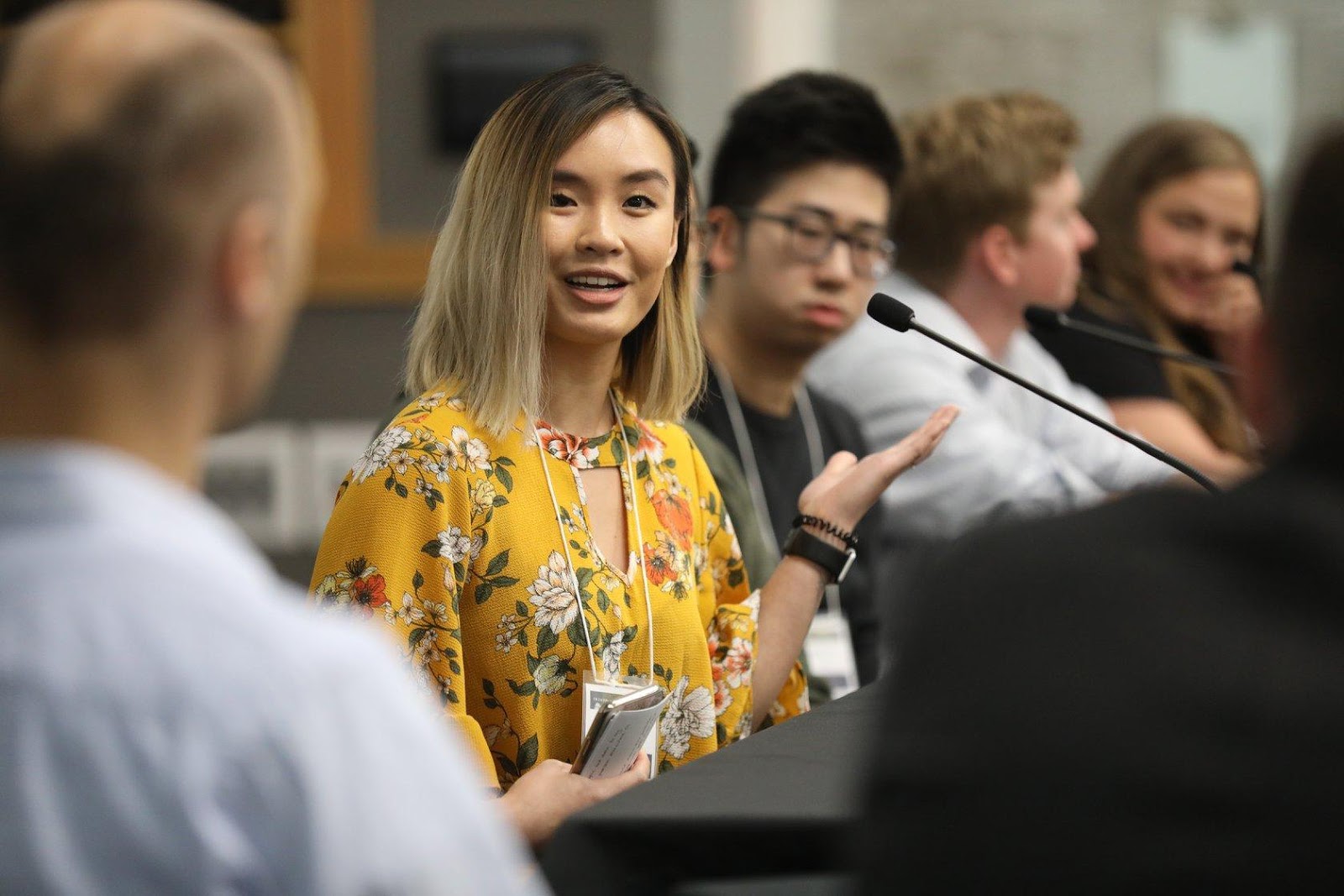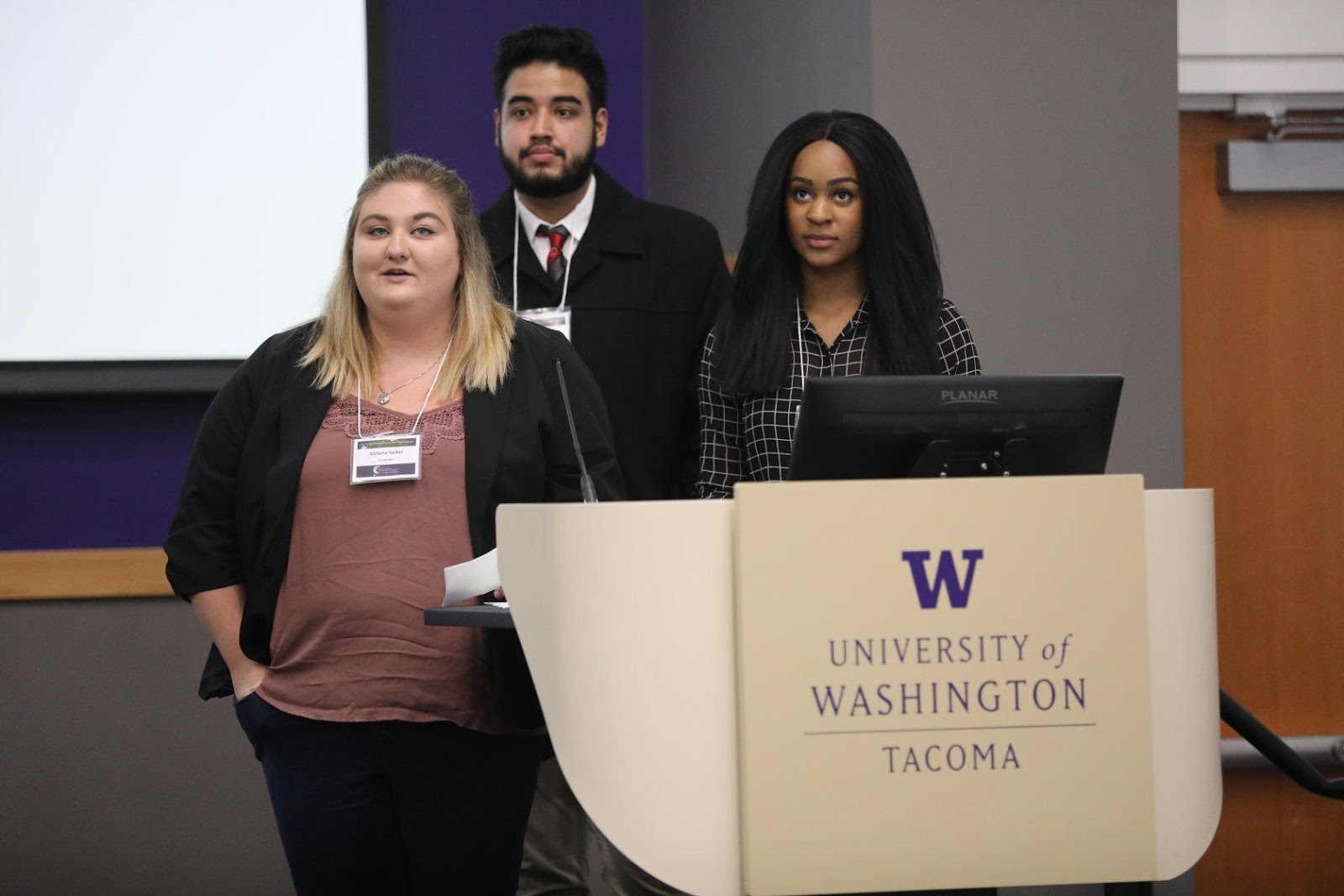Main Content
The 2019 Global Engagement Conference showcased emerging designers and innovations from UW Tacoma. Four teams presented their ideas to address food insecurity issues on campus and in the greater Tacoma community.Principles of engaged human-centered design permeated their innovation process.
An Amazon-pickup style locker to shame-proof UW Tacoma’s Food Pantry service for food insecure students. A recipe-sharing app to connect older generations’ culinary knowledge with students’ need for nutritional and affordable meals. A feedback board to promote a culturally responsive and nutritional shopping experience for residents struggling with food access in East Tacoma. A dynamic website to help a local non-profit coalition better connect community resources with families’ needs.
These compelling ideas captured the imaginations of expert panelists and guests at the 2019 Global Engagement Conference. On May 29th, four student teams presented their design processes and innovations to a diverse audience of community members, local business executives, and higher-education leaders. Their ideas — and the process by which they arrived at them — illuminate the potential of radically inclusive innovation to drive social impact in the South Sound region.
The following profiles give a sense of what this might look like.
Erin Schoch opened her team’s presentation with a story. Thirty years ago, her mom had been a food-insecure student at the University of Washington, struggling to make ends meet while studying for her BA. Despite working full-time and seeking resources, Erin’s mom ultimately had to drop out. However, she instilled in her daughter the value of education. Upon attending UW Tacoma, Erin was shocked to learn that 33% of UW Tacoma students still struggle with food insecurity.
UW Tacoma created the Food Pantry in an attempt to address this need. However, as Erin and her team learned in the course of their research, the Pantry is underutilized. Through their user research with food-insecure students, they discovered that shame was a big factor deterring them from accessing groceries at the Pantry. Students feared facing stigma while picking up groceries. In addition to the lack of anonymity, the team learned that the 9:00 am – 5:00 pm operating hours might not work for everyone – especially people who work full-time on top of school.
Given these needs, the team set out to prototype a solution. The final iteration of their idea – developed through multiple rounds of user feedback – is a food locker modelled after Amazon’s delivery lockers. Students could pre-order specific items online and receive a unique code to access the locker discreetly at a time that works for them. This idea has the potential to reduce the shame felt by students experiencing food insecurity and enable the Pantry to effectively provide food for every student who needs it.

Imagine a Singaporean grandma named Aunt Pauline. She has a wealth of culinary knowledge and wants to share her culturally rich family recipes with younger generations. But she finds most apps besides Facebook, which she recently started using, difficult to navigate. Meanwhile, Felix is a student at UW Tacoma who wants to try different cuisines. He wants to avoid foods like Top Ramen, but has a limited budget for groceries, and finds that most recipes online end up costing more than he can afford.
These user personas — developed through interviews and surveys with real people — fueled Christopher Sim and Isaiah Thao’s imaginations. Sim and Thao decided to build out an app dubbed ‘ChowTime’ to connect users like Pauline and Felix, helping them to meet each other’s needs. After developing wireframes, user journeys, and prototypes in TWRIT 350 Principles of User Centered Design, they developed a beta version of the app. Functionalities for recipe-sharing, social networking, price comparisons between grocery stores, and budgeting were all included in the interface, creating the conditions for cooking traditions to be shared on a budget by a diverse user community.
The East Tacoma community has struggled with lack of access to fresh, healthy, and affordable groceries. Recognizing this, the Tacoma-Pierce County Health Department launched the Fresh Corner Store Program in partnership with local convenience stores to bring nutritious ingredients to the area. How could the health department solicit input of community members to implement this program?
This was the question explored by Lan Allison, Joana Cervera, and Christina Nelson in their project for TWRIT 350 Principles of User Centered Design. In collaboration with Stephanie Wood from the Health Department, they carried out ethnographic research and interviews with community members to generate ideas for a tangible and practical feedback loop tool, one that would enable ongoing program responsiveness.
The final iteration — developed and trialed at the Eastside Community Center — was a feedback board featuring three sections: a question of the week, weekly food facts, and a feedback tree, where community members could write down their requests for specific food items. After observing and talking with community members as they interacted with a low-fidelity prototype, the team added a ‘response’ section to the board, where the grocery store could draw attention to action taken based on community feedback from the prior week. This low-tech design has the potential to help community members feel heard and promote culturally relevant food options. It will also give store owners direct insight into their customers’ grocery shopping needs, so they can stock their shelves accordingly.

The North Pierce County Community Coalition (NPCCC) had a problem: specifically, a non-existent web presence. While they worked tirelessly every day to connect families with resources in the Milton, Fife, and Edgewood communities, they didn’t have the time or funding to build a website. Not having a website compromised their mission of connecting with socially minded organizations to provide coordinated support to families struggling amid rapid gentrification.
Enter students from Dr. Huatong Sun’s TCOM 420 Advanced Web Design class. Over spring 2019, four student teams developed different website prototypes and branding templates for NPCCC using a human-centered design process. One of these teams – comprised of Susan Giske, Erick Rodriguez and Victoria Yackel — presented their website design at the Global Engagement Conference. In-depth consultation and feedback meetings with coalition stakeholders enabled them to highlight the unique strengths of NPCCC as an organization in their website design. Contact forms and resource lists will also enable potential partner organizations and families seeking support to get in touch easily.

How can innovation become reality? How might these ideas make the transition from community to conference, and back to the community again? Some – like the website for NPCCC – are practically ready to go. Others – like ChowTime – require business development and incubation. Similarly, institutional support and action is required to realize the potential of ideas like the food locker or the community feedback board.
As with most innovations seeking social impact, multi-stakeholder collaboration is needed to scale-up solutions. Whatever the implementation process, the principle of including those closest to the problem to design the solutions should guide future action.
The Global Innovation and Design Lab exists to bridge these needs. The presentations at this year’s Global Engagement Conference gave an exciting glimpse of the untapped creative potential of UW Tacoma students and the users they empathized with in their design projects. Imagine the problems that could be solved if this creative confidence were nurtured, resourced, and harnessed to tackle local and global challenges…
